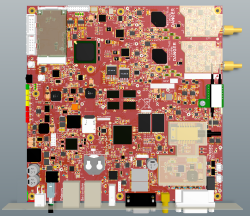ARM Cortex A8 measurement system
|
Powered by a Freescale Cortex A8 800MHz processor, this card cost and size reduced an entire measurement system down onto a single PCB from multiple components housed in a large 19" rack enclosure to something smaller than a ream of paper. The card posed multiple design challenges - integrating a high speed Cortex A8 processor with an FPGA, high-speed ADCs, low noise sensitive analogue receivers and a high power laser driver all on a single PCB. The Cortex CPU runs Linux and is supported by 512MB of DDR2 SDRAM and 2GB of NAND flash for local storage. Further storage expansion is available through use of a mini-SATA flash hard drive module fitted to the board connected via USB, along with a front panel USB connector allowing for memory sticks or USB hard drives to be used. 2 Ethernet ports are provisioned, allowing control and management functionality to be isolated across 2 different networks. An on-board GPS receiver allows for time synchronisation within Linux and also measurement time stamping within the FPGA if necessary. Sensitive low-noise analogue receivers and carefully integrated under screening cans to ensure digital noise from the rest of the system do not impact on the very small signals received from the photo diodes connected to the board. These signals are then conditioned and scaled on their way to the 2 high speed ADCs provisioned to sample the signals at rates greater than 100MSPS. High voltage bias generators controlled by the Cortex CPU ensure the receivers operate properly over the device operating temperature range. Trigger pulses from the FPGA fire the on-board laser driver to generate optical signals for the measurement alongside the signal acquisition and other processing necessary. Power saving features allow the measurement section of the card to be powered down, just allowing the CPU to run at an overall much reduced system power level. A deeper power down is available to allow the CPU to shutdown until woken up by a real-time alarm event in the future. Numerous system ADC channels are provided to ensure that the system is operating correctly and in the event of any system issue, remote status requests may be used to identify problems. Remote command and local data processing / archiving is performed by the CPU, taking the commands from either of the Ethernet ports and data from both the FPGA and system health monitors. By performing all the processing on board with a low power ARM processor network bandwidth and system power can be significantly reduced compared to more traditional systems. The entire card operates from a single +15V to 30V supply consuming under 20 watts of power. |
|
 |
|
 |
|



